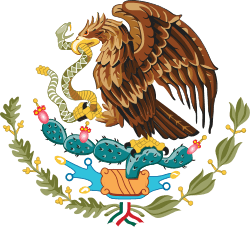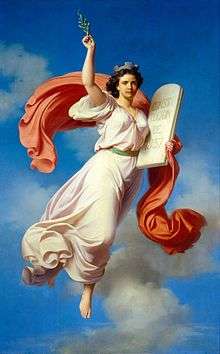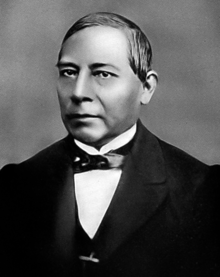La Reforma
Part of a series on the |
|---|
| History of Mexico |
 |
|
Spanish rule |
| Timeline |
|
|
La Reforma (English: The Reform) or Liberal Reform was initiated in Mexico following the ouster of conservative president Antonio López de Santa Anna by a group of liberals under the 1854 Plan de Ayutla. From liberals' narrow purpose to remove a dictator and take power, they expanded their aims to a comprehensive program to remake Mexico governed by liberal principles as embodied by a series of laws and then the Constitution of 1857. The major goals in this movement were to undermine the power of the Catholic Church in Mexico, separation of church and state, reduce the power of the Mexican military, and integrate Mexico's large indigenous population as citizens of Mexico and not a protected class. Liberals envisioned secular education as a means to create a Mexican citizenry. The liberals' strategy was to sharply limit the traditional institutional privileges (fueros) of the Catholic Church and the army. The law prohibiting the ownership of land by corporations targeted the holdings of the Catholic Church and indigenous communities. Indigenous community lands were held by the community as a whole, not as individual parcels. Liberals sought to create a class of yeoman farmers that held land individually. No class of individualistic peasants developed with the Liberal program emerged, but many merchants acquired land (and tenant farmers). Many existing landowners expanded their holdings at peasant expense, and some upwardly mobile ranch owners, often mestizos, acquired land previously held by communities.[1] With the promulgation of the liberal Constitution of 1857, conservatives refused to swear allegiance to it and formed a conservative government. Civil war known as the Reform War or Three Years' War between conservatives and liberals lasted three years, resulting in the defeat of the conservatives on the battlefield. Victorious liberal president Benito Juárez could not implement the envisioned reforms due to a new political threat. Conservatives had sought another route to regaining power, resulting in their active collaboration with Napoleon III's plans to turn the Mexican Empire into a part into the main American ally of the French empire. Mexican conservatives offered the crown of Mexico to Hapsburg archduke Maximilian. The French invasion and republican resistance to the French Intervention in Mexico lasted from 1862-67. With the defeat of the conservatives and the execution of Maximilian, Juárez again took up his duties as president. In this period from 1867 to 1876, often called the "Restored Republic" liberals had no credible opposition to their implementation of the laws of the Reform embodied in the 1857 Constitution.
History



Notable liberal politicians in the reform period include Benito Juárez, Juan Álvarez, Ignacio Comonfort, Miguel Lerdo de Tejada, Sebastián Lerdo de Tejada, Melchor Ocampo, José María Iglesias and Santos Degollado.
The Reforma is usually considered to have begun with the overthrow and exile of President Antonio López de Santa Anna in the Revolution of Ayutla in 1854. There is less consensus about the ending point of the Reforma. Common dates are 1861, after the liberal victory in the Reform War, 1867, after the republican victory of the French intervention in Mexico and 1876 after the Rebellion of Tuxtepec in which Porfirio Díaz overthrew president Sebastián Lerdo de Tejada.
Reforms
The most noteworthy reforms of the Reforma were:
- the Ley Lerdo, abolishing clerical and communal properties.
- the Ley Juárez, abolishing separate military and religious courts
- the Mexican Constitution of 1857, guaranteeing many civil and political liberties including freedom of religion
- the 'Reform Laws' in which the liberal government of Veracruz during the civil war against the conservatives proclaimed complete separation of church and state.
Paseo de la Reforma
Mexico City's main avenue is the Paseo de la Reforma which received its current name after the Reforma.
It was originally known as the Paseo de la Emperatriz after Empress Carlota, the consort of Emperor Maximilian I of Mexico who created the avenue for her.
Notes
- ↑ Gilbert Michael Joseph; Timothy J. Henderson (2002). The Mexico Reader: History, Culture, Politics. Duke University Press. p. 239ff.
Further reading
- Bazant, Jan. Alienation of Church Wealth in Mexico: Social and Economic Aspects of the Liberal Revolution 1856-75 (Cambridge University Press, 1971)
- Brittsan, Zachary. Popular Politics and Rebellion in Mexico: Manuel Lozada and La Reforma, 1855-1876. Nashville: Vanderbilt University Press 2015.
- Callcott, Wilfred H. Liberalism in Mexico 1857-1929 (Stanford University Press, 1931)
- Hamnett, Brian R. Juarez (1994)
- Hamnett, Brian R. "Reform Laws" in Michael S. Werner, ed. Encyclopedia of Mexico: History, Society & Culture (1997) Volume: 2 pp 1239–41.
- Knowlton, Robert J. Church Property and the Mexican Reform 1856-1910 (Northern Illinois University Press, 1976)
- Powell, T.G. "Priests and Peasants in Central Mexico: Social Conflict during 'La Reforma,'" Hispanic American Historical Review (1977) 57#2 pp. 296–313 in JSTOR
- Scholes, Walter V. Mexican Politics during the Juárez Regime 1855-1872 (University of Missouri Press, 1957)
- Sinkin, Richard N. The Mexican Reform, 1856-1876:A Study in Liberal Nation-Building (University of Texas Press, 1979)
See also
- Liberalism in Mexico
- Constitution of 1857
- Reform War (1857–1861)
- French intervention in Mexico (1861–1867)